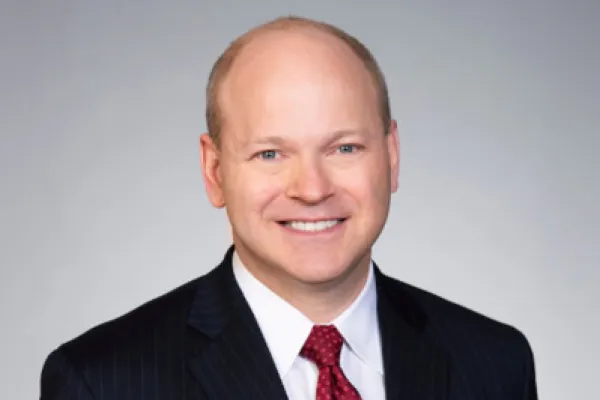
Illustrations by Michael Marsicano
Michael Hawkins was working his first job as an actuary in Regina, the capital of Saskatchewan, when he discovered the loopholes that could bring down the Canadian insurance industry. His boss at Crown Life, a former astrophysicist, told him that if people took advantage of the options that were in plain sight — at least to an actuary — in a broad range of insurance contracts, the companies would all be bankrupt.
Hawkins, a baby-faced farmer with 30-odd cows and a bull on his cow-calf farm who now lives near the uniquely named town of Flesherton in southern Ontario, 50 miles from where he grew up, says, as an example, that insurers sell what’s called term-to-100 life insurance. This type of insurance guarantees that premiums stay the same for the life of the policyholder. As he explains this, it’s December, a week before Christmas, and Hawkins has driven down from his farm to meet me in Toronto at the offices of large Canadian law firm Aird & Berlis.
“Think about it,” says Hawkins. “When consumers stop paying — whether it’s one year or 50 years after they bought the policy — they get nothing and the insurance company is freed from having to pay a death benefit.”
“I bought one when I lived in Regina when I was 25,” he explains. “The premiums I pay today, at 48, are the same as when I bought it. But the policy has no cash value, so people let them lapse all the time, even though when they are 85 or 90, that contract has a lot of value,” says Hawkins. “Insurance companies take advantage of that.”
In the 1990s at Crown Life, Hawkins worked on then-popular universal life insurance products, which also offered holders a range of investments, including short-term accounts that offered guaranteed minimum interest rates between 3 and 5 percent. Crucially, a few had no limits on the amount of money that could be deposited. Insurance companies were aggressively competing with one another to attract customers watching rising stock markets with life policies that included an investment component. Within these products hid Hawkins’ Trojan horse.
By 1997, Hawkins had moved to Toronto to take a job at insurance specialist Buck Consultants. Still working on universal life, valuing the products and helping brokers design them, he was loving his job of analyzing old contracts, some of which were issued by insurance companies long ago acquired by competitors.
In 2000, he started his own firm. One of his consulting clients, an investment banker, asked about hedging the exposure to minimum interest rate guarantees and whether there were limits on the amount of contributions the policyholder could make. “Maybe, maybe not,” Hawkins says he told the client. “If not, that would be an interesting option to hold,” mused the banker, echoing the words of Hawkins’ astrophysicist boss at Crown Life.
Hawkins took the bankers’ words to heart and by the end of 2007 he started a business called Dominion-West Finance to find contracts that didn’t have limits.
Hawkins began researching contracts and found one with no contribution limits that an AIG subsidiary in Canada was still issuing (the subsidiary was later bought by the Bank of Montreal when AIG was bailed out by the U.S. government in 2008). He bought it in 2008. Now he had a contract that he could someday use to earn extra interest on short-term money. If market rates fell below the insurance companies’ guarantee, Hawkins could offer outside clients a higher-than-market rate. He would then pocket the difference between that and what the insurance company was paying.
Hawkins established three limited partnerships for the contracts, named for stops on a Saskatchewan rail line: Mosten, Ituna, and Atwater. He also hired a law firm in Saskatoon to make sure — he rightly anticipated a fight — he was doing everything right.
Hawkins, who played on his high school and college curling teams, knew there were more contracts out there, both from the details of those he remembered over the years and from sifting through readily available public information. But he needed to find owners who wanted to sell and buy the ones with the most lucrative options. That wouldn’t be easy, as only four of Canada’s provinces, one being Saskatchewan, allowed what’s called trafficking — buying and selling insurance contracts. “Sounds bad, doesn’t it?” says Hawkins.
Between 2008 and 2010, after pestering insurance agents for leads on people who no longer wanted policies they bought in the ’90s, Hawkins acquired eight universal life insurance contracts, which are now owned by Manulife Financial Corp., Canada’s largest insurance company; Industrial Alliance Insurance and Financial Services; and Bank of Montreal’s insurance arm. According to Hawkins, all of them offer guaranteed interest rates of at least 3 percent on an unlimited amount of money, bonuses, and other perks. Some allow beneficiaries to be added over time, making the contract last in perpetuity. Hawkins wanted contracts with guarantees that couldn’t be withdrawn, meaning the contracts didn’t have language like “subject to administrative rules” (a phrase that would later become contentious in the court battle).
Hawkins raised money from external clients in 2011.
In 2012, an insurance broker introduced Hawkins to Gary Selke, a former partner in Front Street Capital, which manages hedge funds and other investments. Selke’s family has a long history in hockey: His grandfather, Frank J. Selke, was an executive with the Toronto Maple Leafs and the general manager of the Montreal Canadiens. Hawkins teamed up with Selke, who bought shares in the three partnerships, three years later. Selke became president and CEO of Mosten, Ituna, and Atwater.
“When I first saw the contracts, I was surprised, puzzled, intrigued, curious about the terms,” said Selke in Toronto. “The guys who wrote them clearly didn’t understand them. But the courts interpret insurance contracts in a generally predictable way. If that happened here, then there was an opportunity in front of us.”
Mosten, Ituna, and Atwater are now holders of some of the most valuable universal life contracts in the world. Not surprisingly, the three insurers don’t agree.

Hawkins now finds himself at the center of a bitter fight.
Insurance — like Canada — is rarely the backdrop for such drama. But the current intrigue includes an actuary, a venture capitalist who hails from Canada’s hockey royalty, three insurance companies, and the country’s best lawyers — who are on both sides of the case. (A spokesman for Industrial Alliance provided its latest press release on the lawsuit and declined to comment further. BMO did not respond to a request for comment.)
Although the insurers initially accepted deposits into the contracts — Industrial Alliance took them for six years and paid out half a million dollars in interest — they ultimately stopped honoring them. Manulife accepted deposits from 2010 to early 2016, according to an affidavit from Hawkins filed with the court on November 21, 2016.
Manulife pushed back, sending some existing deposits and new checks back to Mosten. Among other reasons, it cited the actions as not being “in accordance with administrative rules.” After Hawkins specifically asked if he could make a $1 million deposit, Paul Lorentz, general manager of individual wealth management and insurance at the time, responded that the company would not accept it because the so-called carrier fund was only administrative in nature and that it would violate the Insurance Companies Act’s prohibition on deposits. In court documents, Mosten includes copies of other universal life contracts that have language allowing Manulife to invoke administrative rules around certain rights, but the policy Hawkins bought does not include those lines.
After attempting to talk to the companies about a solution, Mosten, which holds the Manulife contracts, filed what’s called an application with the Court of Queen’s Bench in Saskatoon. The application, filed November 23, 2016, asks for a declaratory judgment — which simply determines the rights and legal relationship between parties — to define the rights of the owners of a universal life policy issued in 1997 called the Architect Classic IIe, which Manulife inherited from Aetna Canada after a series of acquisitions. Ituna and Atwater filed similar applications against Industrial Alliance — also in November 2016 — and against the Bank of Montreal in January 2017.
After repeated delays, a trial began in September 2018. The insurers have argued that the court shouldn’t analyze the language of the contracts, explaining that the policies need to be looked at in terms of their purpose and intent and the context in which they were issued. They say the “spirit” of the insurance contracts was just that: insurance; they were not to be used as investments, as the plaintiffs claim. The insurers have filed multiple briefs on “context” that include the history of the Insurance Companies Act, tax policies, and other regulations, including how to calculate reserve requirements. Context, if it’s relevant, though, has to be entirely obvious to the consumer, say legal experts.
Manulife, for one, has pulled out the bankruptcy card. Its expert witness claimed in court that the insurance company will go out of business if Hawkins and Selke are allowed to put an unlimited amount of money into the contracts.
During the three-week trial, Manulife painted a picture of Hawkins and Selke as greedy hedge fund managers trying to turn an insurance company into a money machine.
But at least one portfolio manager at an institutional firm compares Hawkins to Michael Burry, the protagonist in Michael Lewis’s The Big Short. Burry was one of the first investors to detect problems in subprime mortgages and structured securities prior to the 2008 financial crisis; he profited immensely when the market imploded. Hawkins, in that reasoning, is simply exploiting a glitch that no one else had noticed.
“If you are an investment professional, you find these interesting things that are broken in some way. You find something that other people haven’t observed, a mispricing or an error to create value,” says the institutional money manager. “Michael is the person who identified this and then talked to Gary about it. It’s a mini version of The Big Short.”
Doug Steiner, who was a partner at RBC Capital with Selke in the ’90s and later formed a partnership with him investing in electronic-trading service ITG and other startups, says Hawkins is “the most detailed insurance expert I’ve ever met. He’s like a professor of insurance. He runs a farm, yeah, but he and Gary are smart people who have gotten wealthy by finding little niches to exercise their intelligence.”
Unintended niches have a dangerous flip side. “It ties back to the comment Warren Buffett said years ago that derivatives are weapons of mass destruction,” says the institutional money manager. “If you are the one writing these contracts and you’re not careful about what you do, then you create these chinks in the armor.”
“My first inclination was to say, ‘Well, how do you think you can invest however much you want? How do you get there?’ But I’m not sure a judge who has read the briefs will keep that initial response very long,” says a corporate lawyer in Toronto, who I meet after a long walk through the city’s underground mall to avoid the cold.
Manulife and the other insurers argue that to determine the meaning of the contracts, you must read them within the larger context of the insurance industry and what was originally intended. They argue that the contracts were never meant for investment purposes, even though former insurance agents have told Institutional Investor that is untrue and that Manulife’s marketing materials for agents for a similar policy emphasized the benefits of the investment features. For example, buried in court documents, an exhibit shows an illustration of the potential value of the death benefit — which includes the value of the life insurance purchased and the value of the investments at different ages. At age 100, the illustration details, Manulife shows the total benefit would grow to $23 million, representing $1 million in insurance and $22 million in investment value.
The insurers also say that Hawkins and Selke’s plan is absurd, given the regulatory needs of insurers, such as having adequate reserve requirements. The investment accounts, they say, were only meant for premiums to pay for the insurance. Outside lawyers say the language of the contracts is clear and that the insurance companies have chosen the only defense they could, which is to, at all costs, argue for the “spirit” of the agreements.
But there is another twist.
Before Mosten and the other partnerships filed their applications with the court in Saskatoon in 2016, Selke filed whistleblower reports on Manulife with both U.S and Canadian regulators. The reports claim Manulife failed to disclose that the contracts could result in big losses and illegally distributed an investment product. (According to Manulife, the firm has “not seen any ‘whistleblower report,’ and no regulator has identified to us any deficiencies in our disclosures on this matter.”)
Mosten had spent the previous nine months trying to get Manulife to honor the contracts. Using as evidence more than a dozen examples of his interactions with the insurance company and its reasons for rejecting the partnership’s deposits, Selke documents his case.
Selke claimed Manulife should have disclosed the risks of the Architect Classic IIe because between 1997 and 1998, it created about 35,000 of the products, which allow owners to invest an unlimited amount of cash at a minimum rate of interest. The contracts made sense in the late ’90s because Manulife could earn a profitable spread between that minimum and market rates available at the time. However, Selke says, the subsequent decline in interest rates made these products “toxic” and Manulife now has “potentially unlimited exposure and liability.”
What’s more, he used Manulife’s attempts to block him from using the contracts as evidence that they must be toxic. “Manulife is breaching its guarantees and obligations because it is aware of the terms contained in the Architect Class IIe products,” he said in the whistleblower reports.
Once the trial began and Manulife argued that, among other things, it could go bankrupt, Selke updated the whistleblower reports with the new information, building his argument with the insurance company’s own words. When new information was introduced at trial that bolstered the reports, Selke would file another update.
When the trial ended and the judge said he would issue a decision by the end of the year, Muddy Waters, an activist short seller run by Carson Block, announced on October 4 a short position in the insurer and issued a report on Manulife’s potential liabilities, sending the stock down 14 percent. “If the judge rules in Mosten’s favor, they could turn this into the world’s highest-yielding money market. This would be an attractive alternative for fund managers to stash cash and they could stuff Manulife with billions,” Block told Real Vision, a financial news show, in December.
(In a written statement, Manulife asserted that it “takes its disclosure obligations seriously and has complied with applicable disclosure requirements. The Company carefully reviews litigation before making a determination whether to disclose it. The likelihood of a significant loss in this case is remote and therefore the Mosten matter is not material. As stated in our third-quarter 2018 analyst call, we anticipate that Mosten and others who have an interest in undermining confidence in Manulife will continue to resist our position and may have an interest in spreading misinformation.”)
Block stressed that he isn’t making a bet on which way the litigation will go, but instead was shorting the stock because the market wasn’t aware of the risks at the time. Manulife disclosed information about the trial for the first time in a press release on October 4th, after the Muddy Waters report.
Before the judge was able to deliver a decision, the government of Saskatchewan intervened. On October 29, the province changed its insurance regulations to limit the amount of premiums a life insurer may receive or accept for deposit in certain life insurance policies. Manulife then issued a press release saying the regulation changes resolved the case. “Manulife and the other life insurers involved in similar matters plan to make submissions to the court, asking it to dismiss the claims that life insurers can be compelled to accept unlimited premium payments,” the firm said. Industrial Alliance issued a similar statement. Manulife’s stock rose, at least temporarily.
The regulation, which was retroactive, came only a few weeks after the end of the trial and didn’t follow normal procedural processes, such as public comment and discussion. Many rules can take 18 months to be implemented. Other provinces don’t have similar rules on limits. “It’s very unusual for the government to intervene in an ongoing trial,” says Selke. The Canadian Life and Health Insurance Association intervened in the case, saying Mosten’s and the other partnerships’ position is contrary to the intended purpose of the product and the regulatory system in Canada.
Block agreed that the timing of the regulation was odd. “This is suspicious in timing. The regulation was promulgated two or three weeks after we made it public. So they get media attention and suddenly there’s a new Saskatchewan regulation. Interesting insight into our friends to the north,” he told Real Vision.
It’s not the first time insurance companies have struggled after mistakes from bad underwriting, particularly after 2008, when the market downturn and fall in interest rates highlighted the financial impact. Manulife had to issue more shares and borrow billions during the financial crisis after failing to hedge the risk of variable-annuity guarantees. Hartford Financial, Voya Financial, and other insurers sold off billions of variable life or annuity liabilities for a fraction of their costs in the last ten years because the contracts had been a drag on their stock prices.
No one would be fighting about these contracts if it weren’t for low interest rates. The insurers never imagined that long-term interest rates around the world would drop far below 5 percent.
After the Saskatchewan regulation, the judge in the case said he would consider the rule and delayed his decision. Manulife filed a new brief in late December; Hawkins and Selke will file a response at the end of January. The trial will be reopened for three days in February.
Manulife says that it’s all, well, absurd.
“Mosten’s proposed interpretation of the contract is commercially absurd. It suggests that Manulife (through its predecessor, Aetna) entered into a contract that provides a guaranteed interest rate on unlimited deposits,” Manulife said in its brief of law submitted in August.
It’s absurd, the insurer claims, because it could take down the Canadian life insurance industry. As its lawyers write in the brief:
“The potential for mischief if Atwater is successful in its application is that hundreds of millions, if not billions or more, of dollars available to hedge funds and pension funds seeking a highly rated investment opportunity with complete liquidity and an advantageous rate of return, could be deposited into the contracts or into similar UL policies.” Dietrich went on to say that there will be “further specific mischief” if the partnership earns fees to do all that.
It might not be what the insurers intended, but Hawkins and Selke maintain that the contracts are black and white. They say Manulife and the other insurers can solve the problem by offering a new policy in exchange for the old one — for a price, of course. Manulife did something similar for some annuity holders late last year. (Hawkins and Selke, however, do not want to sell their policies.)
“The insurance companies need to get the product back and clean up the mess,” Selke says. “But I’m not aware of a financial product recall. It’s similar to the Tylenol problem, but here the product is bad for the company — and good for the consumer.”





